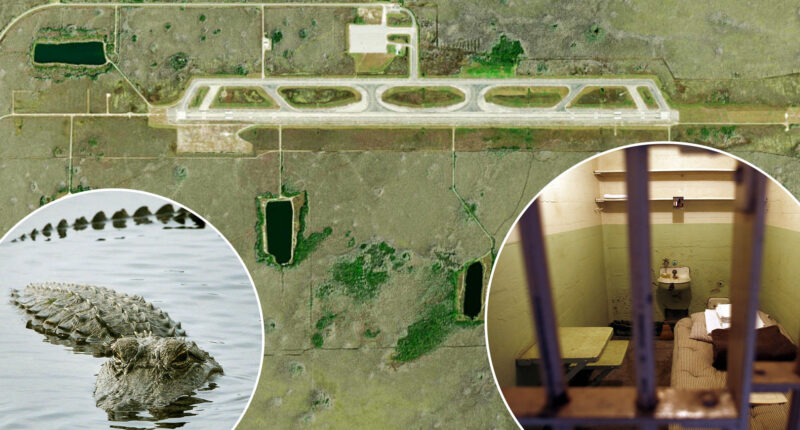PLANS are in place to build a new detention center for migrants and criminals that’s nestled in the Florida Everglades.
An airfield surrounded by pythons and more than 200,000 alligators has been picked as a spot to build the new facility, dubbed Alligator Alcatraz.

Florida’s attorney general, James Uthmeier, unveiled the idea just months after Donald Trump ordered the reopening of the notorious lockup located off San Francisco, California.
Plans are in place to construct a new facility on the 10,500 foot-long runaway at the Dade-Collier Training and Transition Airport, situated approximately 36 miles from Miami.
Local officials estimate that it would cost $450 million-a-year to run the new center, as reported by the New York Times.
Uthmeier boasted that the wildlife would mean the state wouldn’t have to invest heavily in security.
Officials hope they will be able to fit up to 5,000 beds in the facility.
Work on the new center has already begun and is being funded by the federal government.
The criminals would be accommodated in tents and buildings, with National Guard troops ready to assist in processing arrivals, as per reports from the CBS affiliate WPEC-TV.
“We don’t need to build a lot of brick and mortar,” Uthmeier told commentator Benny Johnson.
“It will be temporary, and thankfully, Mother Nature does a lot on the perimeter.”
And, officials have warned that anyone who tries to escape would encounter pythons and alligators.
“If you are detained there, there’s no way in, no way out.”
Uthmeier revealed the facility could be up and running by July, but it’s not yet known how quickly the center could be built.
Local officials, including Daniella Levine Cava, the mayor of Miami-Dade County, want more time to scrutinize the plans.
Levine Cava is concerned about the long-term impact on the community.
And, the plans to build a migrant detention center has sparked outrage.
“The site is sacred, a multi-generational home to Florida’s native people, and is no home for a damaging, unnecessary prison,” Eve Samples, director of the Friends of the Everglades, told Fort Myers News-Press.
Meanwhile, others have claimed the prison would “taint” the local landscape.
“Any type of prison or where you’re caging people up, it’s something that you don’t do (in our world),” Mad Bear Osceola, a local, said.
“It’s really a new concept for us. We are not in favor of putting people in chains like animals.”
LOCALS PROTEST
Osceola’s childhood was spent in a village located near to the site.
Environmental groups protested Uthmeier’s plans to build the facility in the Everglades.
Previously, there were plans to turn the airfield at the Dade-Collier Training and Transition Airport into a new Everglades Jetport.
The plan was unveiled in 1968 before being abandoned two years later.
Its estimated cost was around $2 billion but in 1970, construction had been paused.
The plans for Alligator Alcatraz have been touted just weeks after reports emerged that Trump would send thousands of migrants to Guantanamo Bay.
EXPANDING CAPACITY
In January, Trump suggested he would send up to 30,000 migrants to the notorious base.
Guantanamo Bay was first set up in 2002 by then-US President George W Bush to detain foreign militant suspects following the September 11 2001, attacks.
In a memo, Trump said the order was part of bids to dismantle cartels and restore national sovereignty.
Around 53,000 illegal migrants are being holed up in immigration centers across the US.
The cost of funding more than 41,000 illegals cost Congress $3.4 billion, according to the American Immigration Lawyers Association.
Plans to build the temporary center are designed to relieve pressure on these facilities.
Trump has also called for the reopening of Alcatraz.
He claimed a reopened form of the jail would be a symbol of law and order in the US.
Alcatraz, surrounded by icy Pacific waters, was closed in 1963.
America’s most notorious criminals, including gangster Al Capone and bank robber George “Machine Gun” Kelly, have been locked up in Alcatraz.
Alcatraz Island is now a major tourist site operated by the National Park Service that has over 1.4 million visitors each year.









![Anne Burrell: Food Network Chef Found Dead Near Dozens of Pills [Report]](https://bbcgossip.com/wp-content/uploads/2025/06/Anne-Burrell-Food-Network-Chef-Found-Dead-Near-Dozens-of-380x200.jpg)









